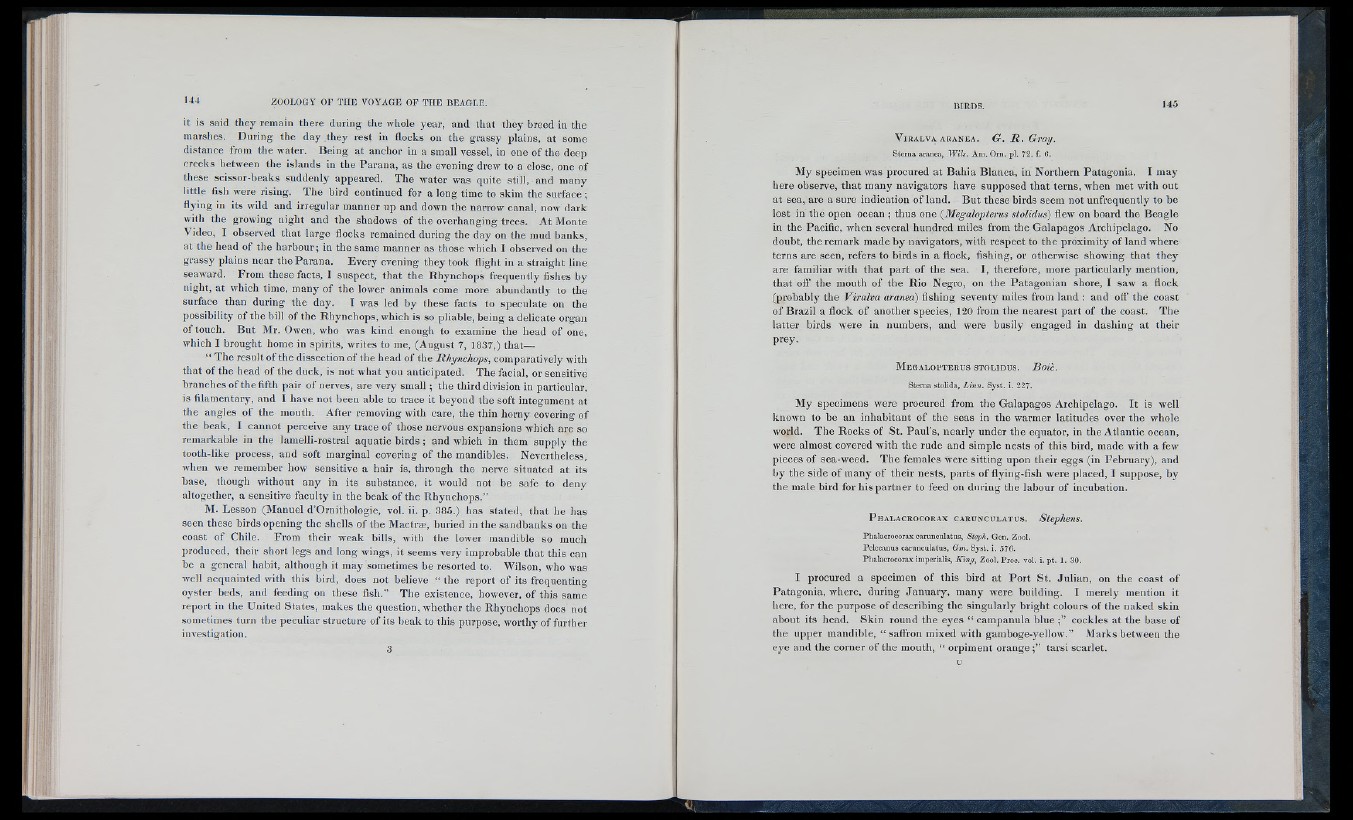
it is said they remain there during the whole year, and that they breed in the
marshes. During the day they rest in flocks on the grassy plains, at some
distance from the water. Being at anchor in a small vessel, in one of the deep
creeks between the islands in the Parana, as the evening drew to a close, one of
these scissor-beaks suddenly appeared. The water was quite still, and many
little fish were rising. The bird continued for a long time to skim the surface;
flying in its wild and irregular manner up and down the narrow canal, now dark
with the growing night and the shadows of the overhanging trees. At Monte
Video, I observed that large flocks remained during the day on the mud banks,
at the head of tlie harbour; in the same manner as those which I observed on the
grassy plains near the Parana. Every evening they took flight in a straight line
seaward. From these facts, 1 suspect, that the Rhynchops frequently fislies by
night, at which time, many of the lower animals come more abundantly to the
surface than during the day. I w'as led by these facts to speculate on the
possibility of the bill of the Rhynchops, which is so pliable, being a delicate organ
oi touch. But Mr. Owen, who was kind enough to examine the head of one,
which I brought home in spirits, writes to me, (August 7, 1837,) that—
“ The result of the dissection of the head of the Rhynchops, comparatively with
that of the head of the duck, is not what you anticipated. The facial, or sensitive
branches of the fifth pair of nerves, are very small; the third division in particular,
is filamentary, and I have not been able to trace it beyond the soft integument at
tlie angles of the mouth. After removing with care, the thin horny covering of
the beak, I cannot perceive any trace of those neiwous expansions which are so
remarkable in the lamelli-rostral aquatic birds; and which in them supply the
tooth-like process, and soft marginal covering of the mandibles. Nevertheless,
when we remember how sensitive a hair is, through the nerve situated at its
base, though without any in its substance, it would not be safe to deny
altogether, a sensitive faculty in the beak of the Rhynchops.”
M. Lesson (Manuel d’Ornithologie, vol, ii. p. 385.) has stated, that he has
seen these birds opening the shells of the Mactree, buried in the sandbanks on the
coast of Chile. From their weak bills, with the lower mandible so much
produced, their short legs and long wings, it seems very improbable that this can
be a general habit, although it may sometimes be resorted to. Wilson, who was
well acquainted with this bird, does not believe “ the report of its frequenting
oyster beds, and feeding on these fish.” The existence, however, of this same
report in the United States, makes the question, whether the Rhynchops docs not
sometimes turn the peculiar structure of its beak to this purpose, worthy of further
investigation.
3
I
V iE A L V A AEANEA. G. jR . Gray.
Sterna aranea, IFi/i. Am. Orn. pl. 72. f. 6.
My specimen was procured at Bahia Blanca, in Northern Patagonia. I may
here observe, that many navigators have supposed that terns, when met with out
at sea, are a sure indication of land. But these birds seem not unfrequently to be
lost in the open ocean ; thus one {Megalopterus stolidus) flew on board the Beagle
in the Pacific, when several hundred miles from the Galapagos Archipelago. No
doubt, the remark made by navigators, with respect to the proximity of land where
terns are seen, refers to birds in a flock, fishing, or otherwise showing that they
are familiar with that part of the sea. I, therefore, more particularly mention,
that off the mouth of the Rio Negro, on the Patagonian shore, I saw a flock
(probably the Viralva aranea) fishing seventy miles from land : and off the coast
of Brazil a flock of another species, 120 from the nearest part of the coast. The
latter birds were in numbers, and were busily engaged in dasliing at their
prey.
M e g a l o p t e r u s s t o l i d u s . Boiè.
Stema stoiida, Litin. Syst. i. 227.
My specimens were procured from the Galapagos Archipelago. It is well
known to be an inhabitant of the seas in the warmer latitudes over the whole
world. The Rocks of St. Paul’s, nearly under the equator, in the Atlantic ocean,
were almost covered with the rude and simple nests of this bird, made with a few
pieces of sea-weed. The females were sitting upon their eggs (in February), and
by the side of many of their nests, parts of flying-fish were placed, I suppose, by
the male bird for his partner to feed on during the labour of incubation.
P h a l a c r o c o r a x c a r u n c u l a t u s . Stephens.
Phalacrocorax carunciilatus, Steph. Gen. Zool.
Pelecanus carunculatus, Gm. Syst. i. 576.
Phalacrocorax imperialis. King, Zool. Proc. vol. i. pt. 1. 30.
I procured a specimen of this bird at Port St. Julian, on the coast of
Patagonia, where, during January, many were building. I merely mention it
here, for the purpose of describing the singularly bright colours of the naked skin
about its head. Skin round the eyes “ campanula blue ;” cockles at the base of
the upper mandible, “ saffron mixed with gamboge-yellow.” Marks between the
eye and the corner of the mouth, “ orpiment orange ;” tarsi scarlet.